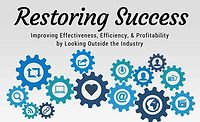Restoring Success: Managing Job Profitability

Managing job profitability in our organizations is an integral part of our complex operations. Although I believe that strong organizations are driven by something bigger than profit and rather by purpose, the fact of the matter is that at a very basic level we must be able to execute in a way that generates a profit. If you have not articulated, communicated, and have gotten in touch with your purpose yet, I encourage you to start with one of my favorite videos my Simon Sinek, "How Great Leaders Inspire Action". Managing job profitability begins with the team being engaged and accountable to their organization’s performance.
Managing job profitability does not need to be a complex administratively intensive concept. The readily available technology in our industry can help make it a streamlined process that allows us to build financially strong organizations, giving tools and information beyond a balance in a checkbook and allowing us to apply cost accounting principles. Managing job profitability is as critically important for smaller organizations as it is larger companies. The following list represents concepts to consider in managing job profitability:
- Team engagement:
- Individual members of the team must be held responsible and have control of the right elements and have access to the appropriate information as it relates to the job’s profitability. For example, companies should be cognizant of the fact that fuel prices and interest rates are increasing both of which can have an impact on job profitability. If a water restoration technician is held accountable to this, it could disengage them from their part in contributing to overall job profitability as they have little control and/or insight as to how your organization may apply these costs. Consider holding the technician accountable to the number of hours that are posted to the job, give access to the goal (expectation) and outcome. This will result in tangible positive outcomes. “Joe, you are consistently executing within 2% of your target, great job!” With rising fuel costs, it may be appropriate to hold a production manager (whomever manages the resources of the company) accountable to control this cost by improving efficiency in deployment, routing, etc.
- The team will better engage with the proper information and tools that allow them to proactively manage the jobs’ profitability. Consider the transparency and accessibility of the systems and information. This may vary with respect to the roles in your organization.
- Avoid complexities in your system. A job profitability system for the purpose of internally managing job profitability should not be complicated or developed to track on a micro level. The result maybe a team that turns their head away from the objective, not out of lack of care, rather from lack of understanding and control. Nobody wants to accept responsibility for something they can’t control.
- The job profitability system and reporting should be:
- Accurately and consistently applied and communicated. The data and information used in the management must be credible.
- At a basic level, an easy to follow and apply job costing system would include all direct costs that apply to the job.
- Materials/supplies
- Labor (In-house and Subcontracted)
- Other: fees, permits, rental expense, other
- Consider the cost vs. benefit of the data your tracking in your system. For example, do the costs involved with the movements and administration of knowing the ounces of cleaning product used on a $800 job have value? How much value to the managing the profitability of the job? What is the true cost of gathering this piece of information? Furthermore, who is held accountable for the variance? Understand the concept of materiality.
- It starts with the scope or budget of the job:
- In the restoration industry, we execute a wide range of work with intricacies that create the ultimate revenue number (estimate/bill/agreed price). Ultimately: Job Profitability (loss) = Revenues minus Costs (Cost of Goods Sold – COGS).
- Scope of work: Having the proper scope of work either before or after the services are rendered is the starting point. If work performed goes beyond the scope (materials, labor, etc.) or services executed are not properly billed, the profitability decreases. Although this seems simple and obvious, good management of job profitability will allow the appropriate accounting, reporting, and accountabilities of this.
- Budget: In the world of restoration, as it applies to job profitability this term can be applied loosely.
- Budget based on a scope: If a scope of work is properly done before the work is executed, that should be representative of a job budget that is readily available to those responsible for the profitable execution of the job.
- Benchmarks: In the world of emergency services, we often deploy and then prepare the corresponding revenue. Your company can establish benchmarks based on experience and review of profitable jobs. Example: A water loss of $XXX = 20 Hours
- A first step to increasing job profitability. A common mistake is to speculate and make assumptions as to why a job or jobs are not hitting the targets of profitability. Job analysis is based on facts.
- Make it a management process to sit down with the appropriate people and break down in detail some good and some bad with the intention of making improvements.
- Find the true root cause of a job failing to hit its target and make the improvement in the process or develop the individuals.
- Some of the most common causes of job profitability that can factually and logically be improved:
- Scope/billing/estimate
- Material costs
- Work performed or materials purchased beyond scope
- Job complexities that were not accounted for.
- Human Resources: inefficiencies, man hours, assigning the wrong person tasks/trades, overpayment to subcontractors
- Mistakes, quality, etc.
As you embark on reviewing or improving the management of job profitability in your organization know that this includes many complexities including but not limited to the effective management of resources. There are other considerations that may be categorized as indirect within your system or organization that includes things like the length of time a job is in progress, adherence to schedule. Managing the collection of receivables will have an impact. The longer the job is in progress or being collected, the more it is touched by your people and systems. Opportunity cost and interest as it relates to time and money may become a factor as well.
Happy running your company profitability and much Restoring Success.
Looking for a reprint of this article?
From high-res PDFs to custom plaques, order your copy today!








